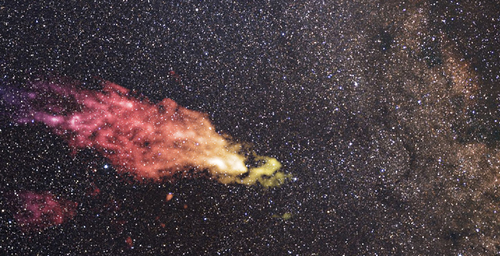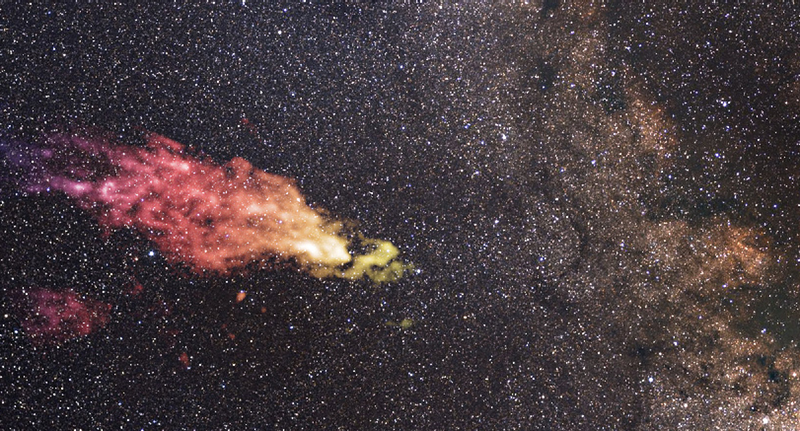Gas Cloud Temperature Constrains Dark Matter
Researchers have come up with a new way to hunt for dark matter, the mysterious material that constitutes most of the mass of the Universe. The technique involves measuring the temperatures of very large, cold gas clouds in the Galaxy and comparing these data with the temperatures expected if dark matter were interacting with the clouds. The observations have already allowed the researchers to nearly rule out the existence of one hypothesized form of dark matter that has gained attention from cosmologists lately. And with additional refinement, this detection technique could further pin down the nature of dark matter.
There is overwhelming astrophysical and cosmological evidence that most of the matter in our Universe is dark matter and that it must be composed of unknown particles that are unlike the quarks and electrons that constitute the familiar world around us. The most popular assumptions are that the particles feel the gravitational force in the usual way but have no electromagnetic charge and interact only weakly (if at all) through the other two known forces. However, decades of laboratory searches have failed to identify such particles. Some alternative theories imagine that the particles have a charge and interact electromagnetically with ordinary matter, although there is no unequivocal evidence for such interactions.
Recently, however, results from the EDGES experiment in Australia [1] have been interpreted by some researchers as a hint of dark matter interacting through the electromagnetic force. EDGES detects radio emissions from hydrogen in the very early Universe, when galaxies were just starting to form, in the first billion years after the big bang. Data from EDGES indicate that these ancient hydrogen gas clouds were colder than expected, suggesting that something unseen was carrying off their heat. Theorist Rennan Barkana of Tel Aviv University in Israel, who is associated with the EDGES collaboration, proposed that large amounts of cold, millicharged dark matter—particles that each carry a small fraction of the charge of an electron—could have scattered off of the hydrogen, extracting some of its energy [2].
Joseph Bramante of Queen’s University in Canada and his colleagues realized that they could test this idea using very cold gas clouds near the center of the Galaxy. Millicharged dark matter, if it exists, would be moving faster today—and thus would be somewhat hotter than it was 13 billion years ago—simply because galaxies have collected so much more mass, providing more gravitational pull. So these particles would now heat gas clouds near the center of the Galaxy, rather than cooling them.
The team combined existing observational data and models of gas cloud cooling to calculate the fastest possible heating rate of these gas clouds. Then they used the millicharged dark matter model to calculate the heating rate that these particles would produce. Finally, they assumed (conservatively) that these gas clouds are being heated solely by millicharged dark matter, which allowed them to calculate how much of this kind of dark matter could exist.
Bramante and his colleagues found that the temperature of these clouds, about 20 kelvin, was lower than it should have been if the type of millicharged dark matter needed to explain the EDGES data were present. However, they did not completely rule out millicharged dark matter; rather, they placed new limits on the properties that such particles could have. For example, if their mass were 100 MeV∕c2, the charge would need to be less than 10−5 of the electron’s charge.
The research team hopes to refine this technique, further restricting the possibilities for millicharged dark matter by modeling other sources of heating and cooling. But complicated, high-energy events near the center of the Galaxy are difficult to model, so tightening the limits will be challenging.
Yet despite the complexity of these processes near the center of the Galaxy, the bounds on millicharged dark matter seem robust. “The nice thing about these clouds is they’re not right smack bang in the middle of the Galaxy,” says Queen’s University team member Sarah Schon. “They are far enough away from the really awful, messy stuff that they still offer some reliable information.”
“I think it’s a lovely idea,” says Tracy Slatyer of the Massachusetts Institute of Technology in Cambridge. “It’s a very direct way of testing for interactions between dark and visible matter.” The research team is optimistic about using these cold gas clouds to place bounds on other dark matter models. “We’re already finding that there are other kinds of dark matter [about which] they have something new to say,” says Bramante.
This research is published in Physical Review Letters.
Correction (26 September 2018): The description of the "most popular assumptions" for dark matter was revised to include the fact that dark matter may interact non-gravitationally, albeit very weakly.
–Adam Becker
Adam Becker is a freelance science writer in Oakland, California.
References
- J. D. Bowman, A. E. E. Rogers, R. A. Monsalve, T. J. Mozdzen, and N. Mahesh, “An absorption profile centred at 78 megahertz in the sky-averaged spectrum,” Nature 555, 67 (2018).
- R. Barkana, “Possible interaction between baryons and dark-matter particles revealed by the first stars,” Nature 555, 71 (2018).





